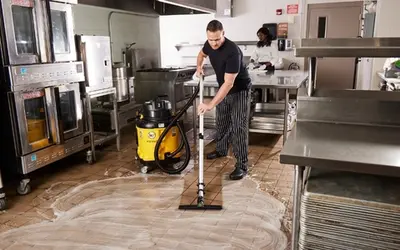3 Ways to Empower Janitors and Custodians to Do Their Best Work

In a tight job market, employee empowerment can mean the difference between engaged employees and a painful labor shortage. This blog presents three ways to empower janitors and custodians to do their best work.
Demotivating Work
We have all worked in an environment that turned out to be demotivating. Whether it was due to unrealistic expectations, unsafe work, or an unpleasant physical space, the situation wears on you. Eventually, you must face the music. Either do the job without the motivation to do it well or seek work elsewhere.
Many janitors and custodians find themselves in this situation. Janitors do difficult tasks with inadequate tools and little support. They face exposure to dirty restrooms and disgusting trash. Often, they don’t feel heard or valued by their employers. This environment repels success, both on an individual and institutional level.
Enter the good news: the opposite also holds true. A healthy, safe working environment where employees feel valued generates success. In work with Kaivac customers, we have seen firsthand how janitors and custodians become empowered to do their best work. This employee empowerment happens when employers do three things: improve ergonomics, increase access to training, and demonstrate empathy and understanding for their employees.
3 Ways to Empower Employees Who Clean
1. Improve Ergonomics
Firstly, empowered employees feel comfortable and productive on the job through improved ergonomics. Ergonomics concerns creating the best possible relationship between the worker and their environment. The work environment includes the physical building, room, and space where they work as well as the tools, equipment, and processes that they use. To improve ergonomics, troubleshoot the work process by identifying and addressing injury risk factors and inefficiencies.
Work-Related Injury Risk Factors
When it comes to the work environment, present discomfort leads to future injury. The Army Center of Public Health offers a great resource on ergonomic injuries and work-related musculoskeletal disorders. In it, they provide seven work scenarios that could give rise to injuries. They include warning signs, risk factors, and the workplace redesigns that helped resolve the situation.
Risk Factors for Ergonomic Injuries:
- Duration
- Compression/Contact Stress
- Position/Posture
- Vibration
- Force
- Temperature (Cold)
- Repetition
We specialize in restrooms, so let’s use restroom cleaning as an example. Wiping down a restroom by hand requires awkward body positions (kneeling, bending, stretching). Mopping a restroom involves uncomfortable position of the wrists and hands coupled with force and duration, as it can take a long time to mop a large tile floor. For both tasks, repetition also multiplies the risk.
To reduce risk factors for ergonomic injury, we switch to a No-Touch Cleaning system, the KaiVac® 1750. The worker stands upright to spray down countertops, partitions, and fixtures. Instead of using force to mop, the worker maneuvers a lightweight wand to vacuum up the soiled solution. While wiping down toilets brings the worker close to surfaces potentially contaminated with pathogens, a No-Touch Cleaning system keeps a healthy distance between the worker and restroom surfaces.
Inefficiencies
To empower janitors by improving ergonomics, tackle inefficiencies. Reducing inefficiencies helps employees get their jobs done with less time and effort. When a worker has all necessary tools and supplies with them, that means fewer trips back to the janitor’s closet. When a No-Touch Cleaning Machine can clean a restroom in 30 minutes that took two hours to clean by hand, that improves efficiency and the worker’s job experience. Anything that helps someone get their job done with less time and effort empowers them to do better.
2. Increase Access to Training
Secondly, empowered employees prepare to succeed through training. If you get what you pay for, then you accomplish what you train for. However, creating a robust training program can be costly and time intensive. To provide high quality training that is also highly accessible, consider a whole new paradigm with an onboard training system. By providing them with accessible training materials to review at any time, employees can help themselves without having to wait on a supervisor for assistance.
All Kaivac cleaning machines come with KaiTutor™, our onboard training interface. KaiTutor is a simplified tablet preloaded with a library of video tutorials on cleaning best practices as well as equipment use, maintenance, and repairs. Workers can play, pause, and review to learn or refresh skills where and when necessary. Janitors can also download KaiTutor as an app to their mobile device.
3. Demonstrate Empathy and Understanding
Lastly, empowered employees feel valued as human beings on the job, because they are treated with empathy and understanding. On the employer’s side, this means assuming the best of employees. If quality lags, the employer asks why and how management can help, rather than doling out stern warnings or punishments. An empowered employee is a collaborative stakeholder in the organization’s success, not someone to be coerced and controlled.
Employee Empowerment Starts Now
Employee empowerment happens one step at a time, and even small changes can make a big difference. Pick one of the above ways to empower janitors and custodians and do something to move the needle today.
Related Posts

Floor Cleanliness and Food Safety Scores
Poorly maintained floors are unsafe and unsanitary. They hold standing water, harbor pests, and cause slip, trip, and fall accidents. Here’s how to improve floor care and your food safety scores.
Read more
UniVac Streamlines Kitchen Cleaning Process; Delivers Superior Results
Cleaning the kitchen floor is your employee’s most dreaded task. They face a physically demanding, multi-step, multi-tool, cleaning and degreasing process. It’s time to improve your process. The UniVac from Kaivac streamlines and standardizes kitchen floor cleaning, delivering superior results every time.
Read more